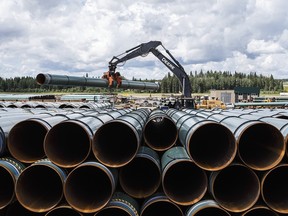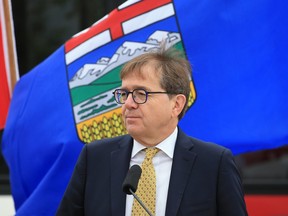
As “green shoots” emerge in the Canadian oilsands and operators roll out aggressive plans to increase production, Enbridge sees the need for more oil pipeline capacity by 2026.
However, don’t expect a major new export pipeline project in Western Canada’s future.
Instead, incremental expansions and plans to tweak existing lines are in the works to bolster the transportation capacity for oil coming out of Canada.
During the company’s investor day on Wednesday, Enbridge indicated it expects to increase the capacity of its Mainline oil pipeline network by 200,000 barrels per day (bpd) — starting in 2026 — as production climbs in the Western Canadian Sedimentary Basin.
According to the Calgary-based company, additional pipeline capacity will be needed as petroleum producers ramp up output by 500,000 bpd by the end of 2025.
Enbridge’s Mainline system, which moved about 3.2 million bpd during the fourth quarter, is already full.
The federally owned Trans Mountain pipeline is expected to start commercial operations of its expansion project in the coming months.
“As has happened in the past, as soon as people think there’s too much pipeline capacity, there’s more production being produced,” Enbridge CEO Greg Ebel told reporters after the meeting.
“There probably won’t be a major pipeline build, but at this point in time, I think with the volumes we’re talking about . . . with low capital and optimization of the current assets that we have, we can add those additional volumes.”
Producers in Western Canada have been cranking up production over the past year as global demand reaches record levels — more than 102 million barrels per day — and with the anticipated completion of the Trans Mountain expansion.
On Tuesday, oilsands producer Cenovus Energy laid out plans to boost its production to about 950,000 barrels of oil equivalent (boe) per day by 2028, up about 150,000 bpd from fourth-quarter volumes.
Canadian Natural Resources pumped out an all-time high of 1.42 million boe per day during the October-to-December period, up 9.6 per cent from a year earlier. And Suncor Energy reported fourth-quarter output climbed to 808,000 boe per day, a six per cent jump from a year earlier.
“Supply growth has surprised,” Colin Gruending, Enbridge’s president of liquids pipelines, said during Wednesday’s meeting. “We are seeing green shoots in the oilsands portfolio.”
Total oil production from Western Canada, which averaged 4.7 million barrels per day last year, could approach five million bpd this year, and get close to 5.4 million bpd by the end of this decade, said Kevin Birn, a vice-president with S&P Global Commodity Insights.
South of the border, production has also set new output records over the past year, averaging 13.3 million bpd in December, according to the U.S. Energy Information Administration.
“Canadian oil and gas is going to grow, U.S. production will hit records and the need for transportation has never been greater,” said Birn.
“A case could be made for a new incremental pipeline, if someone were brave enough to take on that venture.”
-
 Enbridge bullish on Mainline, sees Canadian pipelines maxing out capacity by 2026
Enbridge bullish on Mainline, sees Canadian pipelines maxing out capacity by 2026 -
 Trans Mountain pipeline seeks first crude deliveries
Trans Mountain pipeline seeks first crude deliveries -
 Varcoe: Trans Mountain expansion’s call for oil ‘good news’ for province’s budget surplus, says premier
Varcoe: Trans Mountain expansion’s call for oil ‘good news’ for province’s budget surplus, says premier -
 Varcoe: Canadian oilpatch spending forecast to rise to $40B, even as natural gas producers ‘penny-pinch’
Varcoe: Canadian oilpatch spending forecast to rise to $40B, even as natural gas producers ‘penny-pinch’
For years, that new pipeline was the Trans Mountain expansion (TMX), which was approved by Canadian regulators and the federal government in 2016.
The pipeline is expected to begin commercial operations during the second quarter, transporting oil from Alberta to the B.C. coast for export. The federal Crown corporation that runs the pipeline called for oil from shippers last week.
The expansion will increase the existing pipeline’s capacity by 590,000 barrels per day.
The project has been delayed several times — it was expected at one point to be completed by late 2019 — and its price tag has skyrocketed above $30.9 billion from $5.4 billion.
But given the demise of three other pipeline projects in the past decade — Energy East, Keystone XL and Northern Gateway — experts don’t expect to see another major export project proposed in Canada any time soon.

Chris Bloomer, former CEO of the now-defunct Canadian Energy Pipeline Association and a former oilpatch executive, said oilsands producers are taking projects off the shelf to increase output.
Once the Trans Mountain expansion fills up, more egress out of Western Canada will be needed.
“Everybody will be gun-shy about proposing anything new. They have learned from the past,” Bloomer said in an interview.
“It is going to be very difficult — financially, organizationally, emotionally and politically. I don’t think we will be in a spot to have a major new project come to the table.”
Asked under what scenario the federal government would support additional oil pipelines, Natural Resources Minister Jonathan Wilkinson said it’s important to get TMX into operation. He also pointed to forecasts by the International Energy Agency showing demand for fossil fuels hitting a peak this decade.
“If folks want to bring forward proposals with respect to pipelines that they’re interested in building, obviously we would consider that,” Wilkinson said.
“But I would also say that to build a pipeline is multibillions of dollars, and one has to have some degree of certainty around the projections for demand over decades.”

Optimization and expansion of existing pipelines, along with increasing the amount of crude moved by rail, are potential solutions to allow transportation to keep up with output later in the decade.
Ebel said the company can spend modest amounts of capital on expansions and use drag-reducing agents to boost the capacity of its Mainline system.
“We can continue to be bullish. I think we can continue to be optimistic about the opportunities for the Western Canadian Sedimentary Basin,” he added.
“And I think we can continue to be optimistic about the pipeline capabilities, beyond a big build out, to actually add those volumes.”
Chris Varcoe is a Calgary Herald columnist.
You can read more of the news on source




